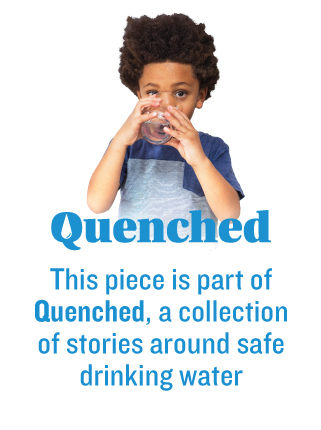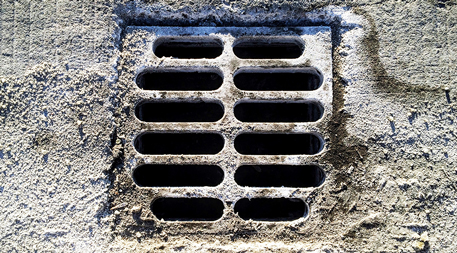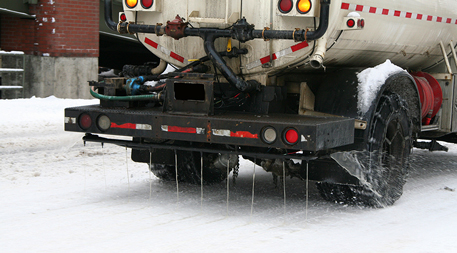November 6, 2017 —  If you live — and drive — in a northern or mountainous climate, you’ve seen highway trucks spreading loads of rock salt on snowy highways to melt the ice. But where does the salt go?
If you live — and drive — in a northern or mountainous climate, you’ve seen highway trucks spreading loads of rock salt on snowy highways to melt the ice. But where does the salt go?
A lot of it ends up in our lakes and streams. A recent study of 371 lakes in North America — most in the northern states and southern Canada — showed chloride concentrations rising in more than a third. More than two dozen were nudging toward levels harmful to aquatic life. Extrapolated to all lakes in the U.S. northern Great Lakes and Northeast regions, about “7,770 lakes may be experiencing elevated chloride concentrations, likely due to road salt runoff,” the study concludes.
U.S. road maintenance departments have been spreading salt on streets and highways to melt snow and ice since the 1940s, but the use of salt skyrocketed over time — from 0.15 metric tons (0.16 tons) per year during the 1940s to about 18 million metric tons (19.8 million tons) per year today. Road salt use is common and growing throughout Canada, Europe, Japan, China and even South America. As much as 60 million metric tons (66 million tons) may be applied worldwide each year. Unlike chemicals that break down into less harmful compounds, road salt persists and may remain in water and soil for years, until it eventually is diluted and carried away by moving water.
Recent research is showing that in many waterways, chloride is on a persistent upward trend, with potential to harm aquatic communities and even impair drinking water.Despite the ever-greater use, road salt’s effects on streams, lakes and groundwater have been largely ignored until recently. As recently as 2014, when biologist Rick Relyea began studying the effects of salt-laden runoff at Rensselaer Polytechnic Institute, “the world of science didn’t pay very much attention to the impacts of road salt on water,” he says. “Now we’re paying much more attention.”
Recent research is showing that in many waterways, chloride is on a persistent upward trend, with potential to harm aquatic communities and even impair drinking water.
Neither Relyea nor other researchers suggest highway salting crews should sacrifice public safety for the sake of healthy streams and lakes, but they say there are ways to cut salt use without impairing winter road maintenance.
Same Old Salt
To melt ice and prevent the accumulation of new ice on winter roads, highway crews apply salt. In the U.S., salt use is heaviest in the Midwest, Great Lakes region, New England, Alaska and the northern Appalachians. Road salt is mostly sodium chloride, the same stuff you sprinkle on food, but in coarse granular form. When it dissolves in slush it lowers the freezing point, causing ice to melt. For the same reason, salt is spread on sidewalks and parking lots.

Calcium chloride (center) and magnesium chloride (right) improve traction at lower temperatures than sodium chloride (left), but they are more expensive and still cause environmental harm. Photo courtesy of Wikimedia Commons
More expensive alternatives, such as magnesium chloride and calcium chloride, work better at temperatures below 15 °F (–9.4 °C). “But they still have chloride, so they’re not any better for the environment,” says Brooke Asleson, metro area watershed project manager for the Minnesota Pollution Control Agency (MPCA).
Chloride is the component of salt of greatest concern for aquatic life. Chloride has been shown to be benign at low concentrations, but as concentrations increase salt can kill plankton, disrupt aquatic communities, increase algae blooms and stunt fish. The U.S. Environmental Protection Agency has set a long-term threshold for aquatic life of 230 milligrams per liter. Canada’s guideline for long-term exposure is 120 mg/liter. (For comparison, seawater has a chloride concentration of nearly 20,000 mg/liter.)
“Just that contrast makes you realize we don’t have a good idea of what concentrations are really harming our environments,” says Hilary Dugan, assistant professor at the University of Wisconsin–Madison Center for Limnology and lead author of the North American lakes study, published this spring in the Proceedings of the National Academy of Sciences.
In many cases, the U.S. and Canadian thresholds are already being exceeded. Keeping freshwater “fresh,” according to Dugan’s paper, “is critically important for protecting the ecosystem services freshwater lakes provide, such as drinking water, fisheries, recreation, irrigation, and aquatic habitat.”
Toll on Waterways
Dugan’s paper tracks long-term chloride concentrations in North American lakes with detailed available records. Most were in what researchers called the “North American Lakes Region,” which includes Connecticut, Maine, Massachusetts, Michigan, Minnesota, New Hampshire, New York, Ontario, Rhode Island, Vermont and Wisconsin.
Mean chloride levels ranged from hardly any at all to 240 mg/liter, above both U.S. and Canadian standards. About 10 percent in the lakes region exceeded 100 mg/liter. And perhaps most concerning, slightly more than a third of the lakes overall showed persistent upward trends in chloride concentrations.

Water laden with road salt can easily contaminate lakes and rivers via storm drains. Photo courtesy of MPCA
Dugan attributes the increased levels to factors such as more roads, bigger roads, more traffic, and more parking lots. The lakes with the greatest long-term concentration of chloride were those with the greatest proportion of impervious surfaces, such as roads and parking lots, in their watersheds. But it didn’t take a lot — as little as 1 percent road surface within a half-kilometer (third of a mile) of the water body. “It was a surprisingly small percentage of impervious surface that led to long-term increases in chloride,” says Dugan. “I’m not sure that anyone expected that percentage to be so low.” According to her study, 27 percent of large lakes in the United States have more than 1 percent impervious surfaces nearby.
Much of the salt runs off these surfaces shortly after it’s applied or with spring melt. But some of it seeps into soil, creating a “reservoir for chloride,” Dugan says. “Even if we stopped applying road salt today, there’s a high likelihood that chloride levels [in lakes] would continue to increase for awhile as some of those chlorides flush out of soils.”

In the Minneapolis–St. Paul area, 19 lakes (red dots) and miles of streams (red lines) are considered impaired by chloride. Image courtesy of the MPCA Chloride Project. Click to expand.
Dugan’s big-picture look at North American lakes squares with Asleson’s finer-grained analysis of Minnesota’s Twin Cities, in which 19 lakes currently exceed the water-quality standard for chloride. And chloride concentrations were increasing in most Twin Cities lakes.
“When you have a watershed area that has a road density of 18 percent or greater [in the entire watershed], that’s where you’re most likely to see water quality problems because of winter deicing salt,” says Asleson.
Trophic Cascades
While chloride is not yet poisoning our waterways, chloride does have the potential to change aquatic communities, stunt fish growth, aid exotic species and even affect tourism.
Rick Relyea is director of Rensselaer’s Jefferson Project at Lake George, a deep, clear 32-mile (51.5-kilometer)-long finger of water in northern New York. Relyea and colleagues monitor the lake and conduct experiments in artificial habitats to determine the effects of chloride and other components of salts on aquatic life.
High road salt concentrations induced a “trophic cascade,” reducing zooplankton and producing an upsurge in their food, phytoplankton, which seemed to thrive in the high salinity.“When some activity like road salt harms one species, it’s usually not the end of the story,” says Relyea. “It indirectly affects a lot of other species.”
In Relyea’s study, high road salt concentrations induced a “trophic cascade,” reducing zooplankton and producing an upsurge in their food, phytoplankton, which seemed to thrive in the high salinity.
Relyea’s team also found that exposure to salt drove zooplankton evolution toward salt tolerance. “Those zooplankton populations that were knocked down by a lot of salt actually bounced back and started doing really well,” he says. That tolerance was passed on to subsequent generations. “That’s really the hopeful message,” he says. “It’s not that we should ignore the issue. It’s hopeful that we could buy some time until we solve the issue.”
In another study, tadpoles raised in salty water became male rather than female frogs at a 10 percent greater rate than expected. The team doesn’t understand the underlying mechanism, says Relyea, but “the explanation is clearly that we have converted some of the females into anatomical males while they are tadpoles.”
Relyea found that salt levels in Lake George are rising but are still far too low to impair aquatic life. Streams in the watershed are a different story. Chloride concentrations spike to levels 100 time greater that those found in lakes, and remain high through the year as chloride leaches from soils. “That’s probably true throughout the northern U.S. and Canada,” Relyea says.
Other research has shown that salt can affect trout growth. Calcium chloride had the greatest effect of common road salts, at chloride concentrations of 860 to 3,000 mg/liter. The effect was greatest at the highest concentration, reducing weight of rainbow trout by more than 30 percent. “If you grow more slowly, you can be more susceptible to predators, it will take you longer to be reproductive, you will lay fewer eggs,” says Relyea. “Growth for a fish is everything.”
High salt use can cause problems for humans, too. Relyea says the sodium in salt can trigger the release of other metals from soil that run into waterways. Released calcium can favor some species over others. “Now you make it easier for some invasive species, like say Asian clams, zebra mussels, various snails — you make it easier for them to get a foothold if they ever arrived in your lake,” he says.
Road salt also damages and kills vegetation, though the effects are concentrated within 200 feet of roadways.
High salt use can cause problems for humans, too. Salt seeps into groundwater, raising the salinity of drinking water. In Madison, Wisconsin, where Dugan lives, “That’s a huge concern for municipalities and water treatment plants,” she says. And according to research by the EPA and U.S. Geological Survey, high chloride increases the corrosion of poisonous lead from old water pipes.
Low-Salt Solutions
Researchers have experimented with salt substitutes such as beet juice, which lowers freezing temperature and melts ice as the sugar it contains dissolves on the road. But the sugar is a fertilizer that feeds algae growth.
“In most lakes, we already have enough nutrients going in, particularly in clear, infertile lakes. They’ll be more green and less transparent and less aesthetically pleasing to most people,” says Relyea. “The less transparent the water becomes, the less valuable the attraction to tourists and the less income that comes into communities.”
Many states regulate road salt storage. But many do not. And none specifically regulates the application of road salt, says Asleson. Instead, road maintenance departments are encouraged to use best management practices. New Hampshire offers a voluntary certification and training program for private applicators maintaining large surfaces such as parking lots. Likewise, Canada has developed a “code of practice” for road salt use.

The use of liquid de-icer instead of solids can reduce the amount of salt needed. Image © iStockphoto.com/katifcam
The MPCA has created a web-based tool for public works departments and other winter maintenance pros to help evaluate their own programs, from small details (Do they overfill their salt and sand trucks?) to big issues (Do they stockpile road salt outside?). “We’ve looked at every aspect that we could with this core group of winter maintenance experts to find every opportunity possible to reduce salt use,” Asleson says.
Asleson thinks the biggest single change to use less salt is switching to liquid solutions. The brine spreads more evenly, stays put and begins working immediately because the salt is already in solution. As a result, spraying liquid brine is more effective while using less salt. Asleson says cities that have switched to tanker trucks have reduced salt use by up to 70 percent and paid back their equipment investment in a year or two.
In northern New York, Relyea says, local governments have been adopting so-called live-edge plows. The plow blade, rather than being solid, is divided into short independently moving sections that follow the contours of the road and better remove snow and ice. That leaves less ice to be removed by chemicals, reducing salt usage. “You still salt, but you don’t salt as much,” he says.
“The salt issue is biologically very complex, but I think it has motivated people to think about how we can simultaneously have safe roads and healthy ecosystems,” says Relyea. “If communities could have the ability through technology to purchase less salt, to salt fewer times, pay less truck driver time and help their lakes that are big tourist attractions, it really can be a win-win for everybody involved. It’s not really about posing the health of ecosystems against public safety.” ![]()
Ensia shares solutions-focused stories free of charge through our online magazine and partner media. That means audiences around the world have ready access to stories that can — and do — help them shape a better future. If you value our work, please show your support today.
Yes, I'll support Ensia!

Not to mention the harm to wildlife and pets when all that salt is dumped on roads and sidewalks and they walk across it and burn the paws.
There has to be better solutions than rushing cars and pets not being to walk on sidewalks.
The math is simple. 40 lbs of salt/month/softener adds up to some huge amounts when you consider how many softeners there are in some lakes. The sooner we switch to softeners that don't use salt the better but I expect the transition to be lost in the legislature for years. State agencies need to start yearly monitoring now so they have the data to convince legislators.
The use of road-salts whether NaCl, CaCl, Kcl, MgCl, Brines, their blends, and the more expensive compounds are heavily promoted by mass-medias. In my travels mass medias use recurring themes before, during and after each winter storm. This in example is by their TV news, weather, etc crews doing show-n-tell video reports near piles of road-salts showing material being loaded onto spreading vehicles, along highways & streets, bridges, parking lots, walks, etc while telling how wonderful road-salts are by providing safety. But, mass medias never report on the consequences of using salts that are dire and numerous. Why? Road-salts rapidly ruin cars, (and everything else plus cause massive pollution harming trees, plants, fishes, all living creatures. ). Mass medias gain huge revenues from car ads. Financiers/ Banks thrive amply from car-loans. Ruin of cars works hand-in-hand with car ads. As a elder wise person said, "If road-salts" assured safety, prevented car crashes, slips & falls, etc such happenings would not occur during ideal weather conditions; sunny, warm, dry, pleasant days." As to the topic of government departments, agencies, states, provinces, counties, cities, towns, they are all heavily influenced by lobbyists, politicians & bureaucrats investments in policies & practices which render their most financial gains. Legislators write laws & regulations that "require the use of salts" as myth of public-safety but are actually tools to invite human obliviousness, recklessness, etc while feeding lawyers with law-suits. The latter create personal, family, & small business fears which insurance companies thrive upon to sell insurance. I think the intelligent people in this forum & website can or already understand the huge problem afflicting 90% of our fellow humans in first-world , but most are being misled. Road-salts have and are destroying roads, bridges, walks, parking garages, building, finishes, cars, trucks, trains, buses, utilities- gas, water, sewer, drains, electric, steam, communications, all infrastructures. Pollution of air, soils, freshwater resources, harming agricultures. Road-salts are among the tools of greed promoted under the illusions of safety. (Beyond this topic so too are other factors of greed promoted by illusions, myths, fears, supposedly to assure safety, security, freedom.)